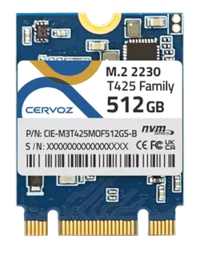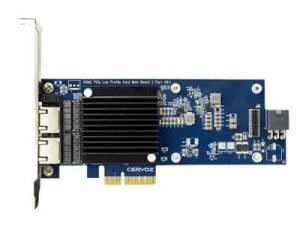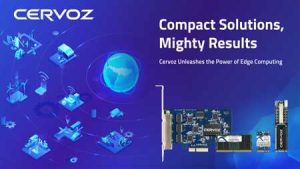Cervoz Unleashes Power of Edge Computing with Compact Solutions and Mighty Results
Including compact NVMe SSDs and DRAM modules, and advanced modular expansion cards
This is a Press Release edited by StorageNewsletter.com on May 29, 2024 at 2:01 pmCervoz Technology Co Ltd. is powering the evolution of edge computing with its solutions.
In today’s data-rich landscape, businesses rely on insights from IoT devices. With advancements in AI and 5G, data volumes surge, straining traditional cloud computing with bandwidth and latency issues. Edge Computing emerges as a solution, processing data at its source for real-time insights crucial for applications like digital twins, autonomous vehicles, and smart healthcare.
The firm, a Taiwan-based company with decades of experience in industrial-grade storage, memory, and expansion solutions, offers solutions to enhance edge computing capabilities. From compact NVMe SSDs and DRAM modules to advanced modular expansion cards, the firm enables integration, optimized performance, and reliability in edge computing deployments.
What is edge computing?
It is a decentralized IT architecture that processes data near its origin, often at the network’s edge. This approach divides tasks from central data centers to edge devices and nodes. It enables faster, deeper insights and enhances responsiveness, improving speed and reducing latency compared to centralized clouds. Typically, an edge computing system comprises 3 layers: device, edge, and cloud.
Device layer
T425 SSD

The device layer, situated closest to the physical world, comprises endpoint devices such as sensors, controllers, and cameras, among others. The layer prioritizes data collection and initial processing for real-time response and efficiency. It requires highly reliable, compact, and energy-efficient components. The company‘s M.2 2230 (A+E key /B+M key) NVMe SSDs and DDR4 SO-DIMM modules optimize this setup with fast data access and efficient storage in space-saving designs. They operate reliably across a wide temperature range (-40°C to 85°C) and feature additional conformal coating and anti-vibration filling for enhanced performance in harsh environments.
Edge layer
The edge layer, composed of edge servers and gateways, serves as a crucial link between device-layer data sources and cloud-based operations. It is designed for extensive data handling, filtering, and analytics, emphasizing quick operations and real-time responses to minimize reliance on remote data centers. For optimal performance, components must manage high processing loads with minimal latency and maximum stability. NVMe SSDs boasting PCIe Gen3 or higher, such as the firm’s NVMe PCIe Gen3x4 SSD, with compact M.2 form factors, advanced DRAM cache buffer, and LDPC ECC technology, are suited for the edge layer. These SSDs enable efficient directory and error correction during high-speed data transfers, thus enhancing data accuracy and reliability.
Cloud layer
T441 SSD

The cloud layer requires intensive processing and long-term storage, performing analytics, operating AI and ML, and managing extensive data systems across various edge locations. It demands high-performing and reliable components. The company’s NVMe PCIe Gen4x4 SSDs excel with RW speeds of up to 7,100/6,190 MB/s and 4K random IO/s up to 1,000,000, with aluminum heatsinks and thermal throttling for overheating issues. DDR5-5600 DRAM boosts this setup with high data throughput and efficient power use, satisfying rigorous computational needs.
Interlayer connectivity
MEC-LAN-PL502 card
 Reliable, low-latency network connectivity is crucial as data flows between the device layer, edge, and cloud. Cervoz 10GbE Low-Profile Ethernet card provides high-speed, stable wired connections in high-bandwidth, low-latency environments. Additionally, the PCIe Compact Low-Profile Ethernet card is for narrow edge device enclosures. For areas where wiring is impractical, M.2 Wi-Fi cards offer wireless flexibility. These connectivity options ensure a foundation for data management across all layers.
Reliable, low-latency network connectivity is crucial as data flows between the device layer, edge, and cloud. Cervoz 10GbE Low-Profile Ethernet card provides high-speed, stable wired connections in high-bandwidth, low-latency environments. Additionally, the PCIe Compact Low-Profile Ethernet card is for narrow edge device enclosures. For areas where wiring is impractical, M.2 Wi-Fi cards offer wireless flexibility. These connectivity options ensure a foundation for data management across all layers.
The company offers solutions to enhance edge computing capabilities. From compact NVMe SSDs and DRAM modules, to advanced modular expansion cards, enabling integration, optimized performance, and reliability in edge computing deployments.














 Subscribe to our free daily newsletter
Subscribe to our free daily newsletter


